
カルセドニーの宝石:特性、意味、価値など
 カルセドニーは微結晶石英の宝石で、数十種類の色を持つ石の仲間です。瑪瑙、オニキス、カーネリアンをご存知ですか?カルセドニー系の宝石については既にご存知ですね!
カルセドニーは微結晶石英の宝石で、数十種類の色を持つ石の仲間です。瑪瑙、オニキス、カーネリアンをご存知ですか?カルセドニー系の宝石については既にご存知ですね!
でも、ちょっと待ってください。カルセドニーは本当に宝石なのでしょうか?はい、カルセドニーとその変種はすべて半貴石です。
カルセドニーの発音は「kal-SEH-duh-nee」です。「chat」のような一般的な「ch」の発音ではありません。
クリスタルカルセドニーはどのようなことで知られていますか?アメリカ合衆国では、カルセドニーのブルーレースアゲートはネブラスカ州の公式宝石です。宝石として、カルセドニーは柔らかなブルーの色合い、手頃な価格、そして多様な種類で知られています。
カルセドニーの意味や用途、種類、象徴性などについて一緒に探っていきましょう。準備はいいですか?

カルセドニー石とは何ですか?
カルセドニーの宝石のほとんどは灰色、白、または青色です。ブルーカルセドニーは最も価値の高い宝石の一つで、ムーンストーンのような内部の輝きである、微妙なアデュラレッセンスが見られることがあります。
カルセドニーはどんな誕生石でしょうか?歴史的に、カルセドニーは5月の誕生石で、今でも双子座の星座石です。今日では、ブラッドストーンは3月の誕生石です。
もうすぐ結婚記念日ですか?カルセドニーの種類は豊富に揃っています!オニキスは7周年、カーネリアンは17周年、クリソプレーズは18周年のお祝いにぴったりです!
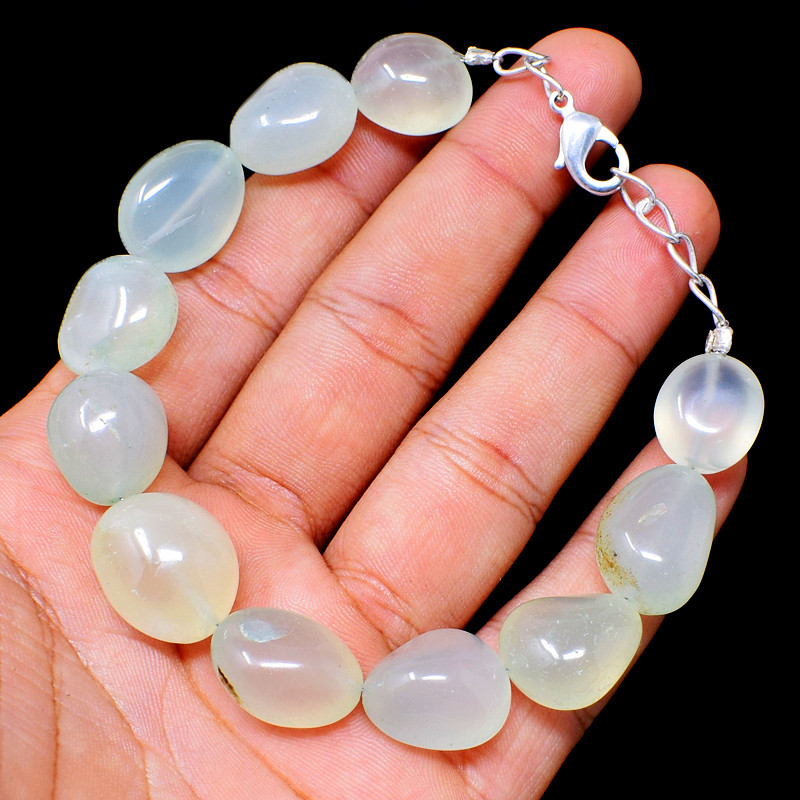
カルセドニーの仕様と特徴
カルセドニーは、二酸化ケイ素(SiO2)からなるクォーツの広いサブタイプです。カルセドニー鉱物は微結晶クォーツですが、これはどういう意味でしょうか?クォーツには、マクロ結晶(目に見える大きな結晶)とマイクロ結晶(目に見えないほど小さな結晶が密集している) の2種類があります。例えば、アメジストやシトリンはマクロ結晶です。
しかし、カルセドニーの定義はそれだけではありません。カルセドニーのほとんどは、微結晶石英とモルガナイトの組み合わせです。モガナイト(モルガナイトではありません)は、石英とは異なる結晶構造を持つ別のシリカ石です。
カルセドニー中のモガナイト含有量は通常1~20%です。しかし、この鉱物はカルセドニー内で石英に変化し、モルガナイトが残らない場合もあります。
カルセドニーのその他の鉱物特性については以下をご覧ください。
モース硬度:6~7
色: 均一、模様、または多色。通常は白、灰色、灰青色、黄褐色、または灰黒。任意の色を示すことができる。
結晶構造:三方晶
光沢:粗いものは蝋状から鈍いもの、磨かれたものは油状からガラス状(ガラスのような)
透明度:半透明から不透明
屈折率:1.53~1.55
密度:2.55~2.91
胸の谷間:なし
骨折:不均一、貝殻状、または貝殻下状
縞模様:白
発光: 時には蛍光を発する。不活性。長波紫外線(LW-UV)では薄緑、黄色、またはオレンジ色。短波紫外線(SW-UV)では緑、薄黄色、または黄褐色。
カルセドニーは珍しいのでしょうか? ほとんどは豊富に存在しますが、種類によって希少性は異なります。その種類については次に説明します。
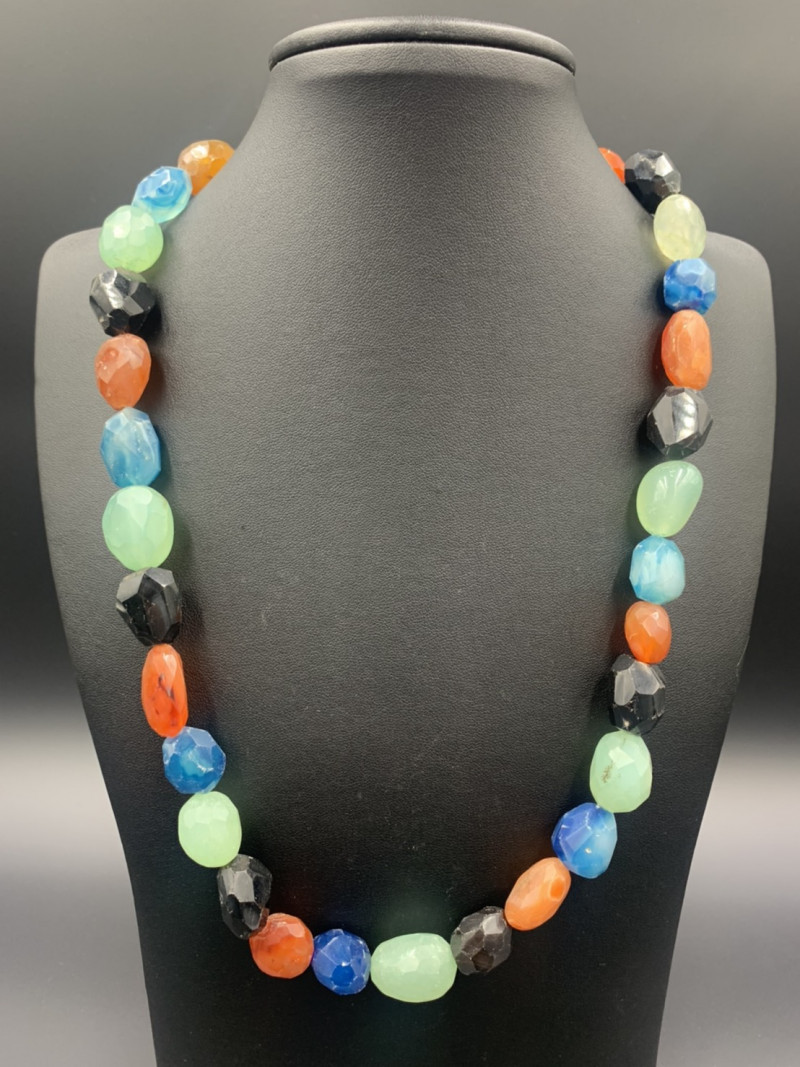
カルセドニーの種類
カルセドニーの種類には、主に単色と多色の2つのカテゴリーがあります。カルセドニーという名称が付けられていない宝石は、通常、単色で半透明、そして白または青であることがほとんどです。
瑪瑙とジャスパーのすべてを網羅するのはこのガイドの範囲を超えていますが、どちらかをクリックすると詳細を知ることができます。色の縞模様のカルセドニーの一般的なルールは、半透明のタイプは瑪瑙、不透明のタイプはジャスパーであるということです。
アベンチュリン

アベンチュリンは、カルセドニーと長石が混ざり合った独特な石です。通常は緑色ですが、様々な色があります。フシュタイトが緑色の色合いを生み出し、フシュタイトの含有量が多いほど、より不透明で鮮やかな緑色のアベンチュリンになります。
この石の特徴は、アベンチュレッセンス、つまり黄鉄鉱、ゲーサイト、ヘマタイトの微細な板状結晶が生み出す金属的な輝きです。これらの内包物の量によって、色の濃淡が生まれます。
ブラッドストーン
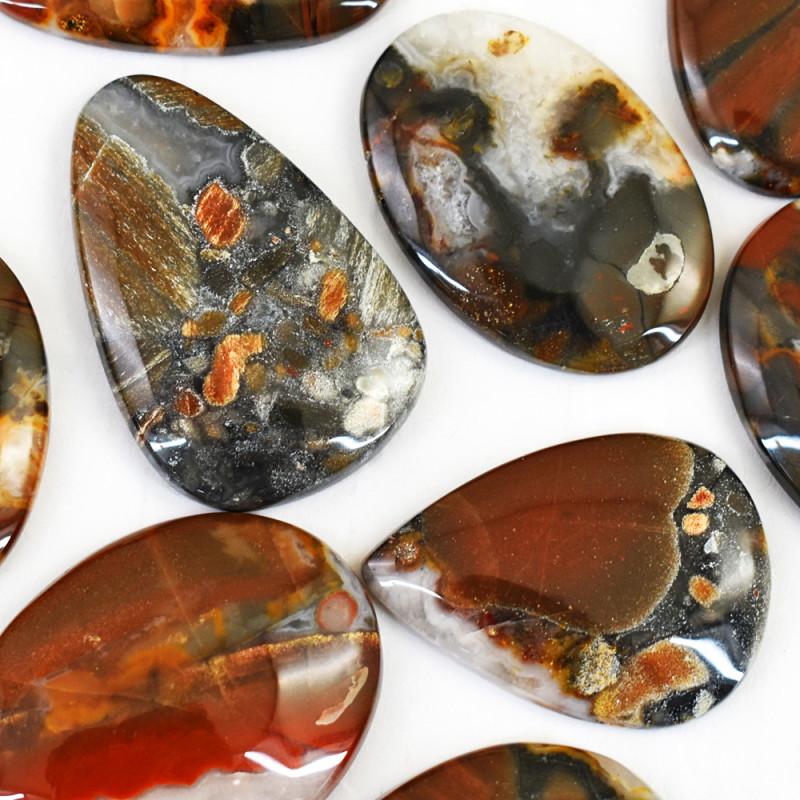
ブラッドストーン、またはヘリオトロープは、不透明な森のような緑色に血のように赤い斑点が入った石です。緑と赤以外の斑点が見られる場合、宝石商は「ファンシージャスパー」と表記することがあります。ブラッドストーンのマーケティング用語として「オリエンタルジャスパー」というものもあります。
ブラッドストーンの色の彩度や模様は、斑点状から条線状、帯状まで多岐にわたります。赤い内包物はヘマタイトに由来します。
カーネリアン

カーネリアンは、赤、オレンジ、黄色の中間色を持つ半透明から不透明なカルセドニーです。単色の場合もあれば、3色すべてが混ざった模様の場合もあります。赤みがかったオレンジ色のカーネリアンが最も価値があります。
この変種はサードに似ていますが、 サードはカーネリアンよりも暗く茶色がかっています。しかし、どちらのカルセドニーも、その色は含水酸化鉄(黄色と茶色)または酸化鉄(赤色)に由来しています。
クロムカルセドニー

クロムカルセドニーは、クロムによって着色された海緑色からエメラルドグリーンの変種です。このほとんど未処理のグリーンカルセドニーは、主にジンバブエ産で、ムトロライトまたはムトロダイトと呼ばれています。
クリソプレーズ
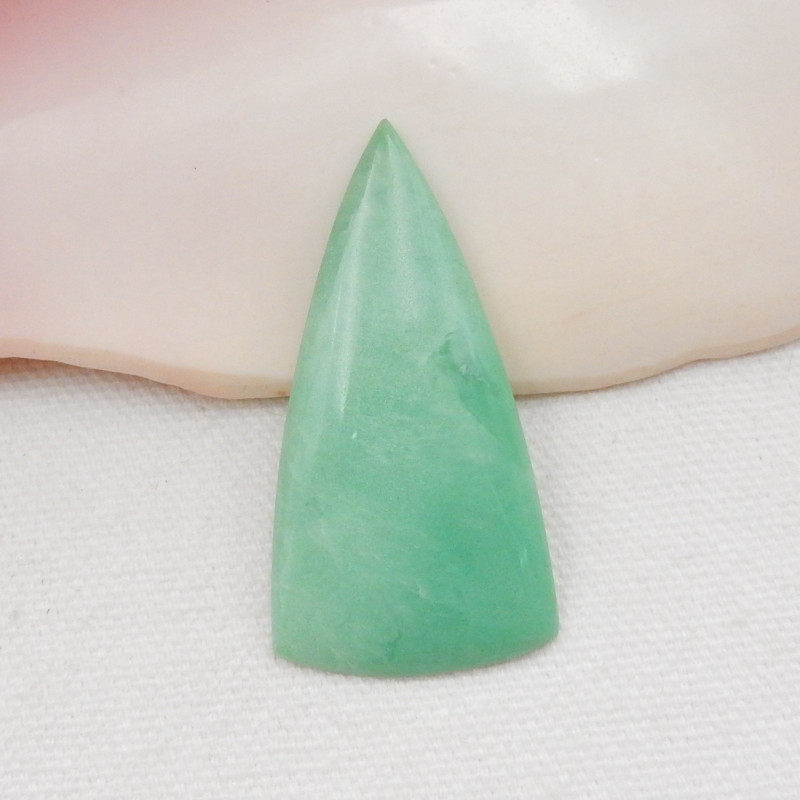
クリソプレーズ(またはクリソフレーズ)は、乳白色の黄緑色から深緑色まで、特にリンゴグリーンの色を持つ緑色の宝石です。カルセドニーの中で最も希少ですが、あまり知られていません。クロムカルセドニーとは異なり、クリソプレーズの緑色は酸化ニッケルに由来します。宝石商の中には、より深みがありながらも鮮やかさに欠ける緑色のクリソプレーズを「プレーズ」と呼ぶ人もいます。
クリソコラカルセドニー(宝石シリカ)
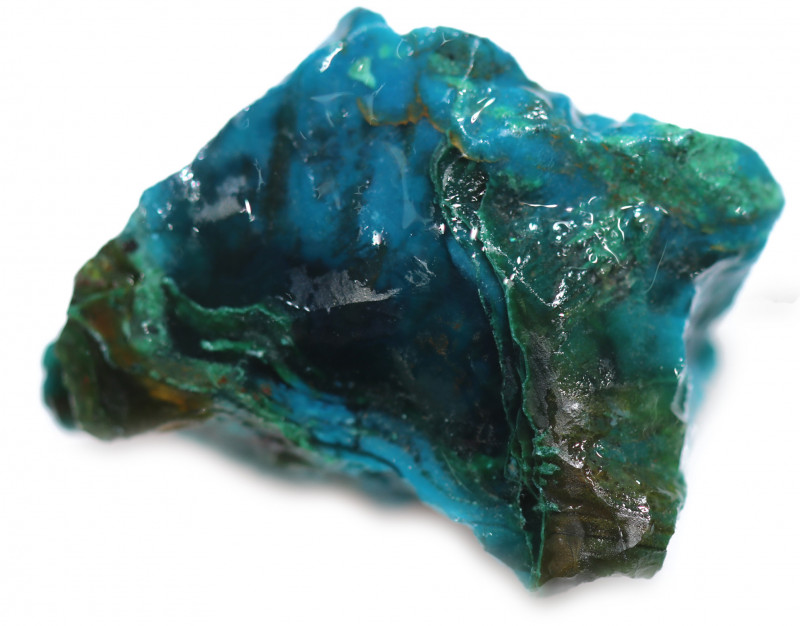
クリソコラカルセドニーは、カルセドニーの中でも最も価値の高い品種です。「ジェムシリカ」として販売されるこの石は、半透明から半透明で、鮮やかな青緑色または青色をしています。
クリソコラの微細な内包物がカルセドニーと共生し、石に独特の色を与えます。クリソコラ・カルセドニーは、内包物の数によって色が不均一になる場合があります。ジオードの中にも、この結晶が見られることがあります。
アクアプレーズTM

アクアプレーズTMは、2014年に発見された最新のカルセドニー品種です。「アクアプレーズTM」という用語は、Avant Chordia社が商標登録したマーケティング用語です。このカルセドニーのサブタイプは、米国宝石学協会(GIA)が2015年冬号の『 Gems and Gemology』で初めて報告しました。GIAは著名なギリシャの宝石探検家、ヤニ・メラス氏からサンプルを受け取りました。メラス氏によると、このカルセドニーはアフリカの特定されていない鉱床から産出されたとのことです。
この変種は半透明で鮮やかな青緑色からターコイズ色をしており、ニッケルとクロムによって着色されています。天然で未処理です。アクアプレーズTMは、その着色剤と吸収パターン( 分光器で観察)によって、クリソプレーズやジェムシリカと区別することができます。
オニキス
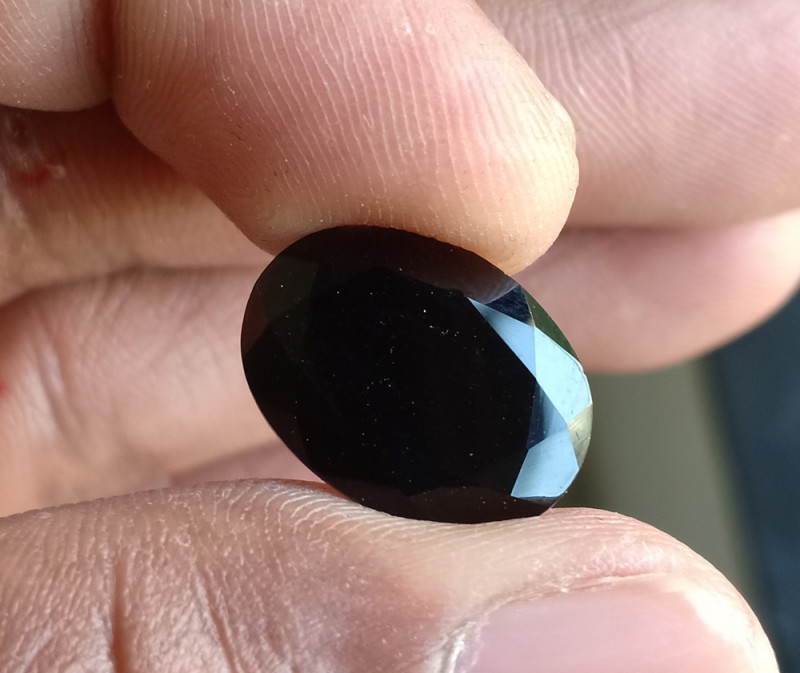
オニキスは、黒、茶、白、時には紫色の平行な縞模様を持つ、濃い色の玉髄です。宝石学者の間では、オニキスが瑪瑙であるかどうかについて意見が分かれており、オニキスの平らで線状の色帯が瑪瑙の曲線的な色帯と区別できると主張する人もいます。
ブラックオニキスの方が馴染みがあるかもしれませんが、この色は自然界ではほとんど見られません。通常、ブラックオニキスは砂糖酸処理や染色処理によって生成されます。
サード&サードニクス
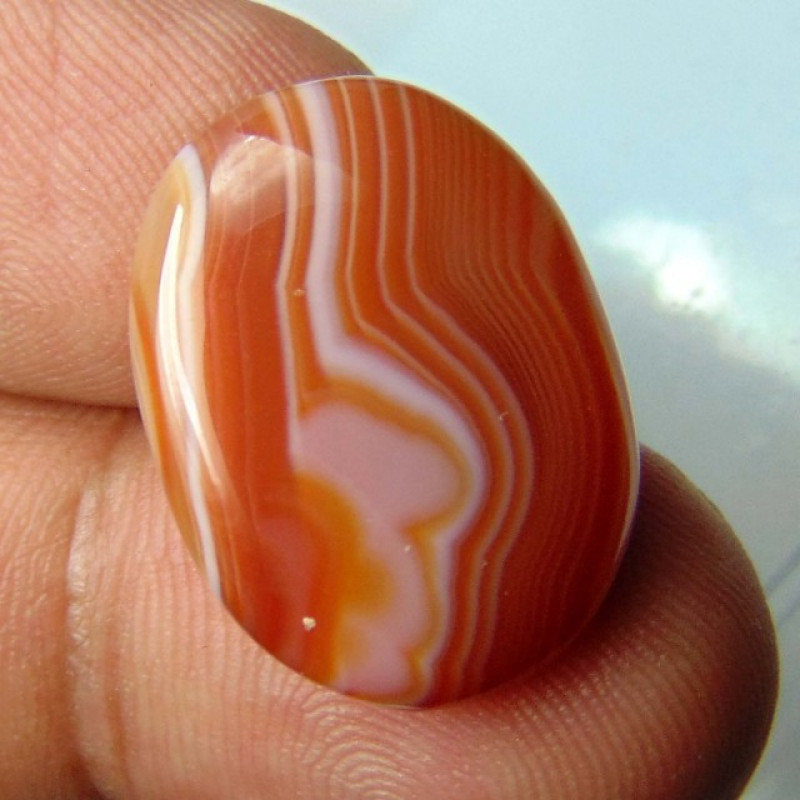
サードは、赤褐色、黄褐色、または茶色の色合いを持つ半透明のカルセドニーです。サードとオニキスが混ざり合うと、カーネリアンのような秋らしい色合いの石になり、サードニクスと呼ばれる色の縞模様が見られます。サードニクスの色の縞模様は、白、黒、またはその両方になることがあります。
さて、鉱物の側面から離れて、カルセドニーの形而上学的特性を探ってみましょう。

カルセドニーの宝石の意味と歴史
まず、カルセドニーは何を象徴するのでしょうか?カルセドニーは静寂、調和、そして安定を象徴します。ホワイトカルセドニーは「調和の石」という愛称で呼ばれています。
月と関連づけられるカルセドニーは、女性的な側面と深く結びついており、「豊穣の石」という別名も持っています。アクアカルセドニーは、兄弟愛(または姉妹愛)と寛大さを象徴する石です。
ギリシャ神話では、カルセドニーの結晶は母なる大地の化身であるガイアと結びついています。古代ローマ人は、この石がスピーチ能力を向上させると信じていました。ケルト神話では、この石はクライド川の女神クロタと結び付けられています。ネイティブアメリカンは、部族の絆を深める儀式において、カルセドニーを聖なる石として用います。

歴史
カルセドニーの名称はラテン語の「chalcedonius」または「calchedonius」に由来します。著名なドイツの鉱物学者ゲオルギウス・アグリコラは1546年、現在のトルコ、カドゥキョイにあった古代の港町「カルセドン」との語源的な関連がある可能性について記しました。
ローマの博物学者大プリニウスは、西暦 75 年の著書『博物誌』の中で、半透明のジャスパーを表すのに「カルセドニー」という言葉を使用しました。
聖書におけるカルセドニーの意味は、ヨハネの黙示録(西暦95年頃)に記されており、現代の誕生石に一部影響を与えた12の礎石の一つです。ユダヤ教では、大祭司の胸当てにあしらわれた宝石には、ジャスパー、クリソプレーズ、サードニクスなどが含まれていました。
カルセドニーの使用(道具や儀式用のナイフなど)に関する最古の考古学的証拠は紀元前3万年に遡ります。カルセドニー製の印章の証拠は、紀元前1800年から紀元後1世紀まで遡る歴史を通じて頻繁に見られます。
シルクロード交易路(紀元前200年から1500年まで活動)の近くに住んでいた人々は、カーネリアンのようなカルセドニーの変種を指輪、ビーズ、彫刻に使用していました。
カーネリアンはイスラム教において特に重要であり、ムハンマドはカーネリアンとカルセドニーの指輪を身に着けていたと伝えられています。彼は「瑪瑙の指輪を身に着けなさい。あらゆる悪から守ってくれるでしょう」と助言したと伝えられています。
時代は現代に移り、ドイツでは1400年代にカルセドニーアゲートの採掘と彫刻が始まりました。1800年代には、イーダー=オーバーシュタインが彫刻や染色が施されたカルセドニー宝石の主要な産地として再び注目を集めました。
古代の人々がどのように使用していたかはわかっていますが、現在カルセドニーは何の役に立つのでしょうか?
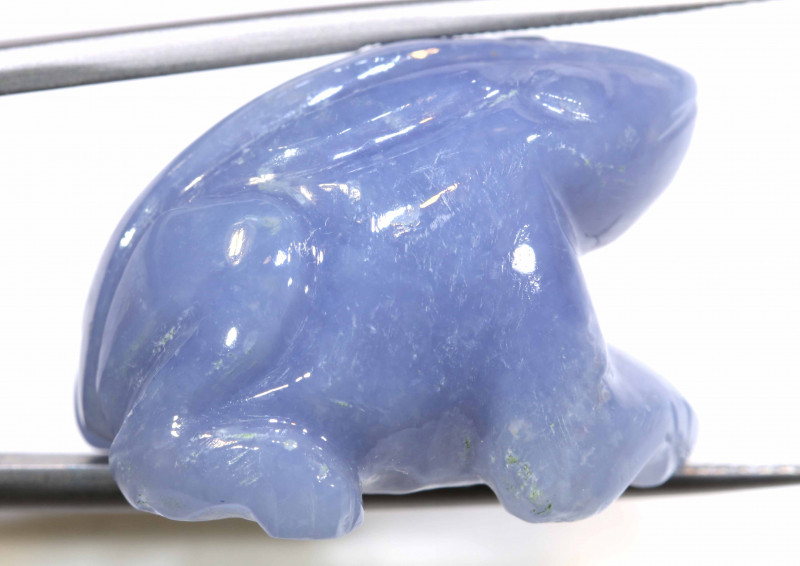
カルセドニーの治癒効果
すべての宝石は、ヒーリングストーンとして精神的な意味を持ち、多くの場合、その色と結び付けられています。カルセドニーはヒーリングストーンでしょうか?もちろんです!
他の青い宝石と同様に、ブルーカルセドニーの効能には、心を落ち着かせ、恐れずに話すことを促してくれることが含まれます。 ピンク色の宝石であるピンクカルセドニーは、優しさ、感情的な癒し、そして優しさを象徴しています。
カルセドニーの身体的、感情的、チャクラの治癒効果についてはどう思いますか?
身体の治癒
カルセドニーのヒーリングストーンは、循環器系や消化器系のトラブルの治療に人気があります。カルセドニーには、免疫力を高め、病気からの回復期に体力を強化する力があるとされています。
クリスタルヒーラーは、スタミナの向上や体の活力回復のためにカルセドニーを使用します。また、ミネラルの吸収や視力の向上のために使用する人もいます。
感情的な癒し
カルセドニーは、感情のバランス、繋がり、そして共感力を高めると言われています。多くのクリスタルユーザーは、カルセドニーを使うことで、より受容的で寛大になり、前向きになれると言います。
もう一つの感情的な効果は、困難に直面した際の感情的な回復力かもしれません。カルセドニーは不安な心を落ち着かせ、安心させることで、自己不信を払拭し、恐れずに自分の気持ちを話せるように促してくれます。
チャクラヒーリング
チャクラは様々な症状に関わるエネルギーセンターです。バランスが取れていると全体的な健康状態を促進し、チャクラストーンはチャクラのバランスを整えてくれます。カルセドニーはどのチャクラに効果がありますか?カルセドニーは喉のチャクラに最適です!
喉のチャクラは、自分の心の奥底を理解し、自信を持って真実を語ることを助けてくれます。喉のチャクラが詰まると、弱気になったり、恥ずかしがったり、言葉が出なくなったりすることもあります。
ブルーカルセドニーを使用するとこのチャクラが開き、自己認識が向上し、正直に話すことができるようになります。
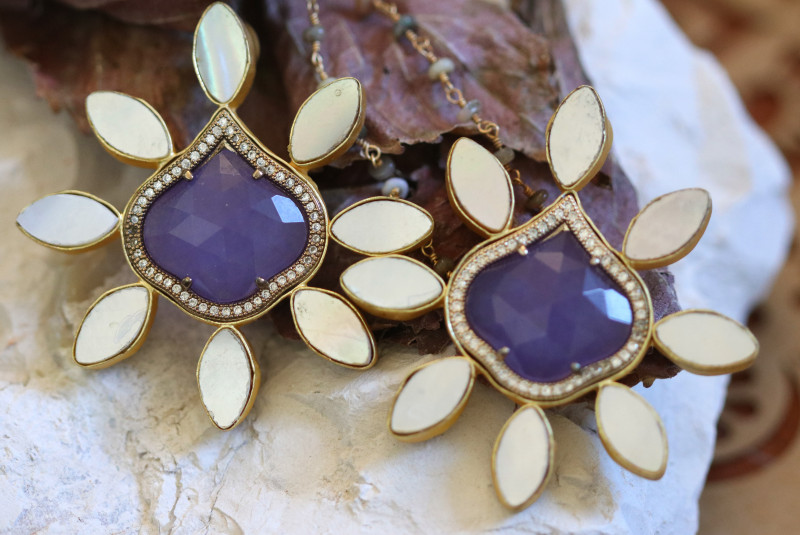
カルセドニーの宝石特性
宝石の特性は、専門家が石の品質と価値を判断する際に用いるものです。カルセドニーの価値を高めるものは何でしょうか?カルセドニーの価値は、色、カット、透明度、そして処理によって決まります。
色
カルセドニーの色は、銅、鉄、ニッケル、チタン、クロムなどの不純物によって生じます。単色のカルセドニーの中で最も一般的な色は白ですが、淡い紫、灰色、青もよく見られます。
カルセドニーの中で最も希少な色は何ですか?天然の濃い青色で均一な色合いのカルセドニーは最も希少で価値が高いですが、ピンク色もかなり珍しいです。カルセドニーのブルーの色合いは実に多様で、ピンクやグレーの色合いを帯びていることが多いです。
天然カルセドニーの色はどれも、彩度が高いほど価格が高くなります。
カット
カルセドニーには、標準的な形状からファンシーシェイプまで、様々なファセットカットが施されたものがあります。ファセットカットされたカルセドニーは通常、半透明から半透明です。
しかし、宝石職人は通常、ビーズやカボションのようなファセットカットのないカットを選びます。どちらもカルセドニーのネックレスに最適です。また、カルセドニーのジュエリーや装飾品には、彫刻が施されることも一般的です。
明瞭さ
ほとんどのカルセドニーには、目に見えるほどの内包物があり、不透明、あるいは半透明で乳白色に見えます。カルセドニーは、 カラーストーンのクラリティグレードになるほど透明ではありません。しかし、半透明のカルセドニーは最も高値で取引されます。
内包物の少ない半透明のカルセドニーは、内包物の多いカルセドニーよりも価値が高くなります。単色のカルセドニーにおいて価値のある内包物は、シャトヤンシー(「キャッツアイ」効果)をもたらす、平行で密集した繊維状結晶のみです。
治療
カルセドニーは、特に無色で乳白色の標本には、処理が施されることがあります。染色と加熱は、色を鮮やかにしたり変化させたりするために行われる典型的な処理です。処理は淡色の石に最もよく行われますが、染色前に漂白される場合もあります。
加熱処理により、鉄不純物を含むカルセドニーは鉄の酸化により赤みを帯びることがあります。加熱処理は通常、目立たず、安定した状態を保ちます。
宝石職人は、淡い色のカルセドニーをより鮮やかに見せたり、クリソプレーズのような希少な品種に似せたりするために、カルセドニーを青や緑に染めることがよくあります。青や緑に染められたカルセドニーは、不自然なほど明るく、 チェルシーフィルターで見るとピンク色に見えます。

カルセドニーの形成と産地
カルセドニーの形成は、高温のマグマが移動するところから始まります。火山活動によってマグマは地表直下の地殻へと押し上げられます。高温のマグマが冷えて固まると、ガス泡が発生し、最終的に固まった岩石の中に空間が残ります。
シリカとミネラルを豊富に含む水が空間に入り込み、水が蒸発するにつれてミネラルが結晶化します。カルセドニーの基本構造はシリカと酸素によって、そして色は様々な不純物によって形成されます。
サードニクスのような色の縞模様のあるカルセドニーの混合物は、ミネラル豊富な水が何度も沈殿し、新たな鉱物がもたらされることで形成されます。これらの沈殿によってカルセドニーとサードニクスの層が形成され、色の縞模様が生まれます。
採掘場所
カルセドニーの鉱床は世界中のほぼすべての大陸に分布しています。ブラジルとアメリカ合衆国は、おそらく最も多様なカルセドニーの品種を産出しています。
主要な産地とそれに対応するカルセドニーの種類をリストしました。
アリゾナ州、アメリカ- クリソコラカルセドニー
オーストラリア- クリソプレーズ、ブラッドストーン、オニキス、サードニクス
ブラジル- カーネリアン、サード、ブラッドストーン、クリソプレーズ、アベンチュリン、オニキス、サードニクス、ピンクカルセドニー
カリフォルニア州、アメリカ合衆国- 「モハベ」ブルーカルセドニー、クリソプレーズ、オニキス
エジプト- カーネリアン
アイスランド- 「アクア」カルセドニー
インド- ブラッドストーン、カーネリアン、サードニクス、アベンチュリン、オニキス
インドネシア- 紫色のカルセドニー
マダガスカル- オニキス、クリソプレーズ、カーネリアン、ブラッドストーン
メキシコ- クリソコラカルセドニー、
ナミビア- 「アフリカンブルー」カルセドニー
ネバダ州(アメリカ) - 「マウント・エアリー」ブルーカルセドニー
オレゴン州(米国) - 「ホリーブルー」ラベンダー色のカルセドニー、オニキス
ロシア- クリソプレーズ、オニキス
トルコ- クロムカルセドニー、ブルーカルセドニー、クリソプレーズ
ウルグアイ- カーネリアン、サード、オニキス
ジンバブエ- クロムカルセドニー
重要な疑問に答えましょう。カルセドニーは高価な石なのでしょうか?ほとんどの場合、そうではありませんが、種類によっては他の種類よりも高価になるものもあります。

カルセドニーの価格と価値
カルセドニーは一般的に豊富な資源であるため、価格も比較的安価です。まずはブルーカルセドニーの価格帯を見てみましょう。
深い青色と優れた透明度を持つファセットカットのブルーカルセドニーは、1カラットあたり15ドルに達することもあります。乳白色の透明度を持つ淡いブルーカルセドニーは、ファセットカットで1カラットあたり0.70~3ドル、カボションカットで1カラットあたり0.40~3ドルで卸売価格で取引されています。
アメリカ合衆国オレゴン州産の淡いブルーからラベンダー色の「ホリーブルー」カルセドニーは、最も価値の高い宝石の一つです。鮮やかなブルーの高品質な原石は、1オンスあたり14~20ドルです。淡い色合いの低品質の原石は、1ポンドあたり40~150ドル(1オンスあたり2.50~10ドル)です。
最も価値の高いクリソコラ・カルセドニーは、カットの良いものなら1カラットあたり100ドル以上で取引されることもあります。これらの宝石は、鮮やかな青色、内包物がなく、透明感も完璧でなければなりません。しかし、クリソコラ・カルセドニーの原石は1カラットあたりわずか0.80ドルから1.50ドルです。
クリソプレーズも貴重ですが、より手頃な価格で、高品質のファセットカットされた宝石は1カラットあたり2~12ドルで取引されます。一方、このカルセドニーは産地によって1カラットあたり20~40ドルに達することもあります。クリソプレーズの原石は卸売価格で1カラットあたり1.50~2ドルです。

カルセドニーのお手入れとメンテナンス
宝石の適切な手入れ方法を知っておくと、カルセドニーを新品のような輝きに保つことができます。
まず、カルセドニーは日光に当てても大丈夫でしょうか?状況によります。未処理のカルセドニーのほとんどは熱や光に敏感ではありません。ブルーカルセドニーの中には日光で色褪せてしまうものもあり、放射線照射されたカルセドニーは熱に敏感です。
カルセドニーは水に浸けても大丈夫ですか?はい。実際、クリソコラカルセドニーは水に浸すことで色を鮮やかにすることができます。ただし、ほとんどのカルセドニーは長時間の浸け置きは避けることをお勧めします。
カルセドニーの最も安全な洗浄方法は、柔らかいブラシ、ぬるま湯、そして低刺激性の石鹸を使用することです。染色されたカルセドニーをお持ちの場合は、超音波洗浄機、アセトン(マニキュアの除光液など)、家庭用化学薬品は避けてください。
衝撃や破損を防ぐため、激しい運動をする前にはカルセドニーのジュエリーを外してください。他の宝石とは分けて、布張りの暗い容器に保管してください。
カルセドニーの宝石を購入したいですか?
もし今、カルセドニーに夢中になっているなら、それは当然です! 数千年にわたる歴史的用途と豊富な種類を誇るカルセドニーは、あらゆる好みやスタイルに合う宝石です。しかも、お手頃な価格帯なので、どんなご予算にもぴったりです!
豊かな歴史を持つ、美しくユニークな宝石をお探しですか?カルセドニーの宝石を今すぐご購入ください!
Gemstone Encyclopedia検索
最新記事
ヤシ象牙彫刻は、植物象牙とも呼ばれ、南米のヤシ科植物フィテレファス属のヤシの実から倫理的に採取された、象牙の天然代替品です。このガイドでヤシ象牙についてすべて学びましょう!
15th Jan 2026
レインボーラティスサンストーンは、様々な内包物によって3つのゴージャスな光学的効果を持つ長石の一種です。燃えるように鮮やかな色合いと格子模様が、コレクターにとって希少な宝石となっています。
12th Jan 2026
記事のカテゴリ
How To's is where you will find helpful articles from gem Rock Auctions on how to cut gemstones, select gemstones and buy gemstones.
9記事数

